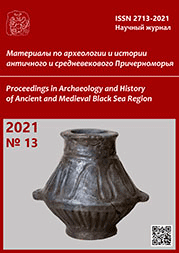Подвал II в. н.э в районе городской площади Танаиса (раскоп XIX)
The basement of the 2nd c. CE in city square area of Tanais (excavation unit XIX)
Author(s): Yu.K. Guguev, S.A. NaumenkoSubject(s): History, Archaeology, Cultural history, Ancient World
Published by: Нижневартовский государственный университет
Keywords: Tanais; basement; Middle and Late Sarmatian cultures; Alans and Meotians; amphorae; red-lacquer ceramics; non-antique grey-clay pottery; tamga-shaped symbols;
Summary/Abstract: In 1996, a basement of a building was excavated by the German research team of the Lower Don Archaeological Expedition in the city square area of Tanais. The basement feature (No. 3, so-called Eastern basement) was revealed to make a part of the building No. 4 within the excavation unit XIX. The basement is referred to among complexes resulted from ravage caused by the late Sarmatians as they defeated the city around the mid-2nd century. In the filling of the basement, a large number of finds have been discovered: amphorae, red slip ware, fine tableware, wheelmade gray clay ware, handmade pottery, a lamp, two arrowheads, two keys, a lock, an astragalus, a bone object, iron nails, and five coins (from Aspurgus to Rhoemetalces). Among the amphorae, many varieties have been represented, such as (a) red clay ones of the Zeest 84 Type, (b) orange clay ones of the Tanais Homesteads 20-21 Type, (c) brown clay one produced by unidentified centre, with high handles and flat bottom, (d) narrow-necked ones from Heraclea made of light-coloured clay (Shelov’s Type C), and (e) others. Red slip ware is represented by various forms of the Pontic sigillata A and by two fragments of the Pergamene sigillata. In general, the dating of amphorae as well as that of red slip ware falls within the interval from the late 1st to the mid-2nd century CE. Among non-antique pottery, gray clay vessels made by the Alans make up a noticeable amount of six out of fourteen items, while in the dump layers formed as a result of the cleaning of the city after the defeat is finished, fragments of Maeotian ceramics absolutely prevailed as compared with Alan ones. On the surface of one of the Maeotian vessels, a relief tamga-like Sarmatian sign is imprinted, the other one represents a ‘table’ with three short legs, similar to those used in everyday life by the nomads like the Sarmatians and the early Alans of the Caucasus. It is these facts which may testify a “barbaric” origin of those who owned the basement.
Journal: Материалы по археологии и истории античного и средневекового Причерноморья
- Issue Year: 2021
- Issue No: 13
- Page Range: 535-577
- Page Count: 38
- Language: Russian

